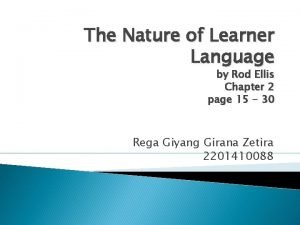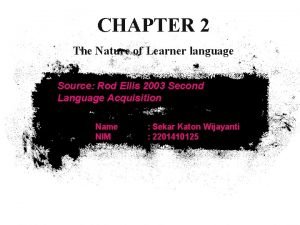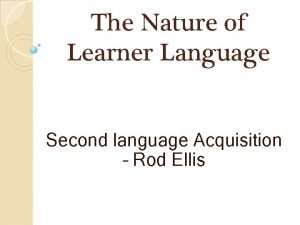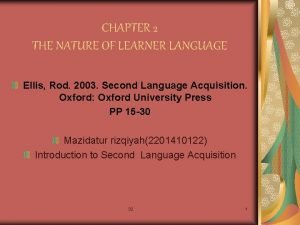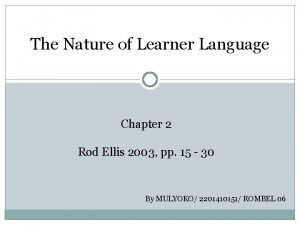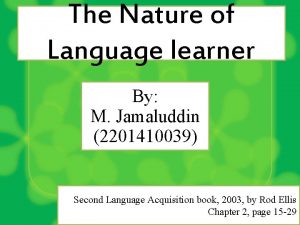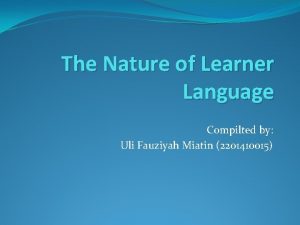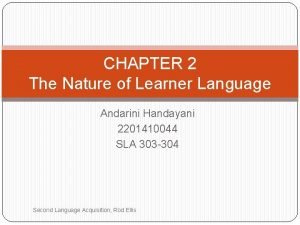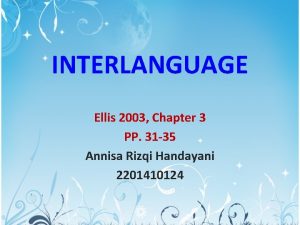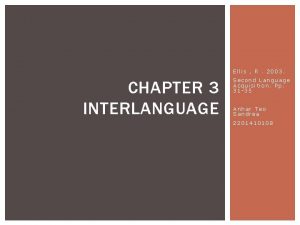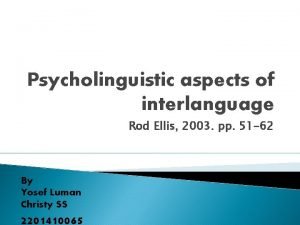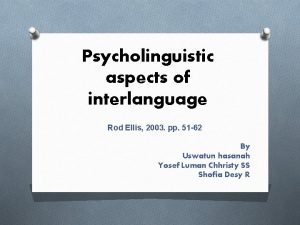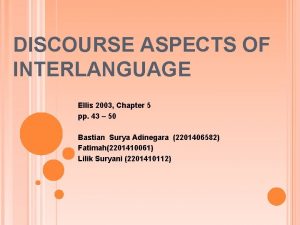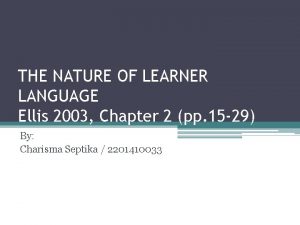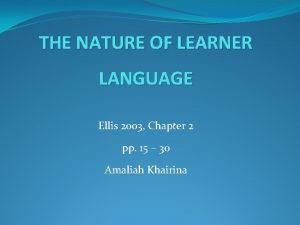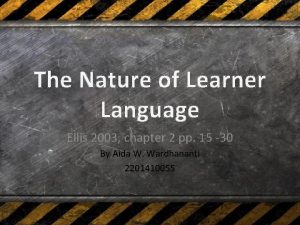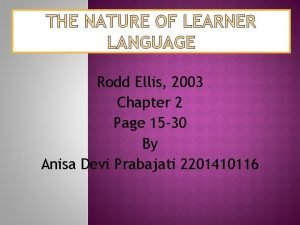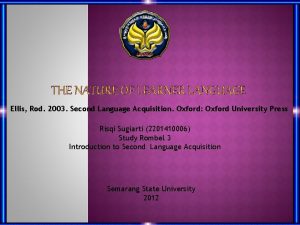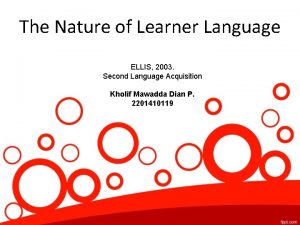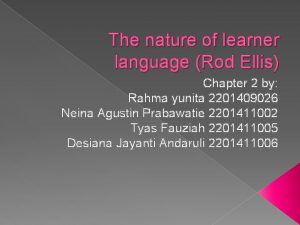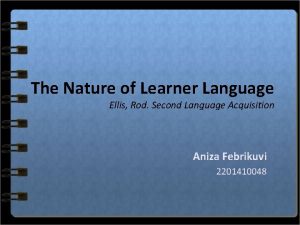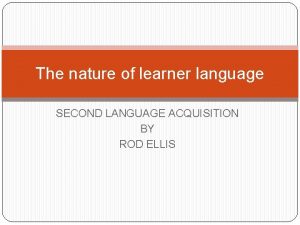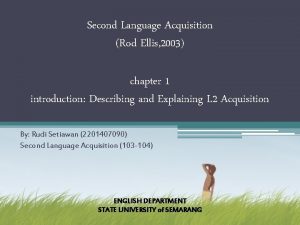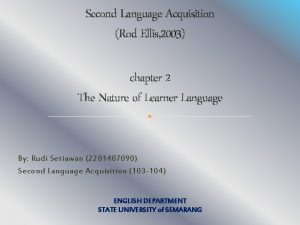THE NATURE OF LEARNER LANGUAGE Ellis 2003 Chapter

















- Slides: 17

THE NATURE OF LEARNER LANGUAGE Ellis 2003, Chapter 2 PP. 15 -30 By. Annisa Rizqi Handayani

ERRORS AND ERROR ANALYSIS There are good reasons for focusing an errors: 1. They are a conspicuous feature of learner language, raising the important question of ‘Why do learners make errors? ’ 2. It is useful for teachers to know what errors learners make 3. Paradoxically, it is possible that making errors may actually help learners to learn when they self-correct the errors they make.

1. Identifying Errors • To identify errors we have to compare the sentences learners produce with what seem to be the normal or ‘correct’ sentences in the target language which correspond with them. • Errors reflect gaps in a learner’s knowledge; they occur because the learner does not know what is correct. • Mistakes reflect occasional lapses in performance; they occur because, in a particular instance, the learner is unable to perform what he or she knows.

2. Describing Errors There are several ways of describing and classifying the errors into types: • Classify errors into grammatical categories • Identify general ways in which the learners’ utterances differ from the reconstructed target language utterances. • Such ways include ‘omission’, ‘misinformation’, and ‘misordering’

3. Explaining Errors • The identification and description of errors are preliminaries to the much more interesting task of trying to explain why they occur. • Errors are, to large extent, systematic and, to a certain extent, predictable. • Errors are not only systematic; many of them are also universal.

• Errors can have different sources. Some errors seem to be universal, reflecting learners’ attempts to make the task of learning and using the L 2. • Learners commit errors of omission and errors of overgeneralization.

4. Error Evaluation • The purpose of the error analysis is to help learners learn an L 2, there is a need to evaluate error. • Some errors can be considered more serious than others because they are more likely to inference

DEVELOPMENTAL PATTERNS • Many errors that L 2 learners make are universal: all learners are learning naturalistically or in a classroom, and irrespective of their L 1, make omission, overgeneralization, and transfer errors.

1. The Early Stages of L 2 Acquisition • We can find out how a language is learned as a natural, untutored process by investigating what learners do when exposed to the L 2 in the communicative settings. • In such circumstances, some L 2 learner, particularly if they are children, undergo the silent period.

When learners do begin to speak in the L 2 their speech is likely to manifest two particular characteristics: • One is the kind of formulaic chunks which we saw in the case studies. • The second characteristic of early L 2 speech is propositional simplification.

2. The Order of Acquisition • To investigate the order of acquisition, researchers choose a number of grammatical structures to study. • Then, they collect samples of learner language and identify how accurately each feature is used by different learners. • That enables them to arrive at an accuracy order.

• A crucial theoretical questions, whether L 2 acquisition is the result of environmental factors that govern the input to which learners are exposed, or of internal mental factors which somehow dictate how learners acquire grammatical structures.

3. Sequence of Acquisition • When learners acquire a grammatical structure they do so gradually, moving through a series of stages en route to acquiring the nativespeaker rule. • The acquisition of a particular grammatical structure must be seen as a process involving transitional constructions.

4. Some Implications • The work on developmental patterns is important for another reason. It suggest that some linguistic features are inherently easier to learn than others. • This has implications for both SLA theory and for language teaching.

VARIABELITY IN LEARNER LANGUAGE • Learner language is systematic and variable. • One linguistic form can trigger the use of another form. • The effect of linguistic context are also evident in learners’ use the verb ‘to be’. • Learners also vary the linguistic form they use in accordance with the situational context.

• Another important factor that accounts for the systematic nature of variability is the psycholinguistic context. • A characteristic of any natural language is that forms realize meanings in a systematic way. • The particular form-function mappings which learners make do not always conform to those found in the target language.

• Variability in learner language is clearly not just random. • Learners have access to two or more linguistic forms for realizing a single grammatical structure but they do not employ the arbitrarily.
 Lazy and eager learning in machine learning
Lazy and eager learning in machine learning The nature of learner language
The nature of learner language The nature of learner language
The nature of learner language The nature of learner language
The nature of learner language The nature of learner language
The nature of learner language The nature of learner language
The nature of learner language The+nature+of+language+learner
The+nature+of+language+learner The nature of learner language
The nature of learner language The nature of learner language
The nature of learner language Ellis 2003
Ellis 2003 Ellis 2003
Ellis 2003 Psycholinguistic aspects of interlanguage
Psycholinguistic aspects of interlanguage Rod ellis 2003
Rod ellis 2003 Social and discourse aspects of interlanguage
Social and discourse aspects of interlanguage Nature and nature's laws lay hid in night meaning
Nature and nature's laws lay hid in night meaning Nature nature controversy
Nature nature controversy Hát kết hợp bộ gõ cơ thể
Hát kết hợp bộ gõ cơ thể Ng-html
Ng-html

